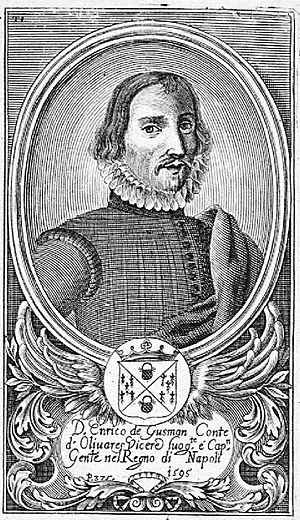Enrique de Guzmán, 2nd Count of Olivares facts for kids
Enrique de Guzmán y Ribera (born March 1, 1540 – died 1607) was an important Spanish nobleman and a smart politician. He was known as the 2nd Count of Olivares. He served the King of Spain in many big roles, like being an ambassador and a viceroy.
Contents
Early Life and Royal Service
Enrique de Guzmán was born in Madrid, Spain. His father was Pedro Pérez de Guzmán, the 1st Count of Olivares. Enrique started working for the royal family when he was very young.
When he was just 14, he traveled around Europe with his father. They were serving Prince Philip, who later became King Philip II of Spain. Enrique also fought in a war in Naples and in the Battle of St. Quentin (1557). He was hurt in the leg during this battle. Some say he used this injury later as an excuse to avoid things he didn't want to do!
When his father passed away in 1569, Enrique took over the family's important position. He continued to work closely with King Philip II. He even helped with important talks about the king's new marriage to Elizabeth of Valois.
Serving as an Ambassador
Enrique de Guzmán held many big jobs for King Philip II. He was a treasurer, a castle warden, and even Spain's Ambassador to France.
In 1582, when he was 42, he became the ambassador to Rome. For the next ten years, he represented Spain to three different popes: Gregory XIII, Sixtus V, and Gregory XIV.
Challenges with Pope Sixtus V
Things were often difficult between King Philip II and Pope Sixtus V. King Philip wanted the Pope to speak out against French Catholics who supported Henry of Navarre. But Pope Sixtus refused.
Olivares, as the ambassador, first tried to persuade the Pope. Then he even threatened him! This made their relationship much worse. The Pope asked many times for Olivares to be replaced, but King Philip wouldn't agree. The problem finally ended when the Pope died.
Another disagreement was about the Jesuits (who answered to the Pope) and the Spanish Inquisition (who answered to the King). They were rivals, which added to the tension.
A Strong Personality Clash
Olivares had a very strong and proud personality. This caused more problems, especially with Pope Sixtus V, who also had a very strong character. The Pope even disliked the King of Spain.
There was so much disagreement between Olivares and Sixtus V that when the Pope died, people rumored that he had died from anger caused by Olivares! They said Olivares "poisoned his days."
The Bell Story
A historian named López-Calderón, who lived at the same time as Olivares, shared some interesting stories about the ambassador and the Pope.
For example, Olivares used a bell to call his servants. But only Cardinals of the Church were allowed to do this! The Pope sent a Cardinal to ask Olivares to stop. Olivares refused, and the issue became a big deal.
The French ambassador also complained about Olivares. The Pope sent Olivares a letter telling him off. Olivares met with the Pope three times about this. He grew more impatient each time. He argued that Spain was the biggest and most powerful Catholic empire. He said Spain gave more money to Rome than any other kingdom. He demanded he be allowed to keep using the bell. He even accidentally called the Pope "your ingratitude" instead of "your piousness"!
But the Pope wouldn't change his mind, and Olivares had to stop using the bell. After this, Olivares started calling his servants by firing a small cannon from his roof! The noise and shaking caused so many complaints that Pope Sixtus soon gave Olivares permission to use a bell again.
The Lapdog Story
Another story says Olivares got very angry because the Pope was distracted during a meeting. The Pope was playing with a small lapdog instead of paying attention. Olivares angrily took the dog from the Pope and put it on the floor!
After Pope Sixtus V died, things got much better with the next Pope, Gregory XIV.
Viceroy in Italy
From 1591 to 1595, Olivares was appointed viceroy of Sicily. A viceroy is like a governor who rules a region for the king.
In November 1595, King Philip II made Olivares the viceroy of Naples. His time in Naples was known for good harvests. Olivares also worked hard to stop bandits there. He also started building projects, working with a famous architect named Domenico Fontana.
While serving in Sicily, Olivares made the coast stronger against attacks from Ottoman and pirate ships. He led successful raids against Ottoman ships and bombed cities like Tripoli, Misrata, Tunis, and Alger. He was rewarded for these efforts.
When King Philip II died in 1598, the new king, Philip III of Spain, kept Olivares as the Viceroy of Naples. Historians from that time praised his work in Italy as both an ambassador and a viceroy.
Olivares returned to Spain in 1599. He became a member of the Spanish Council of State, which advised the king. He passed away in Madrid in 1607.
Family Life
Olivares was married to María Pimentel de Fonseca. They had several children:
- Jerónimo de Guzmán, who died when he was a baby.
- Gaspar de Guzmán, Count-Duke of Olivares, who became a very important advisor to King Philip IV of Spain.
- Francisca de Guzmán
- Inés de Guzmán, who married Álvaro Enríquez de Almansa.
- Leonor María de Guzmán, who married Manuel de Acevedo.
See also
 In Spanish: Enrique de Guzmán para niños
In Spanish: Enrique de Guzmán para niños


